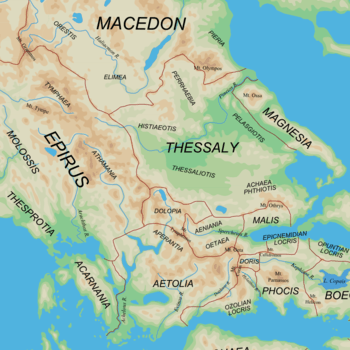Bruttius Sura
Quintus Bruttius Sura (also known as Quintus Braetius Sura) was a Roman commander who fought in the First Mithridatic War. He was the first Roman commander to successfully resist Mithridates' advance.[1][2]

|
Honorific inscription at Larissa |
|
|
Rubbing in majuscules: Modernization with reconstruction: Translation: | |
An inscription from Larissa in Thessaly honors Q. Braetius Sura and is the only source stating his full name.[4]
During the war, he was a legate to Gaius Sentius Saturninus, the Roman propraetor of Macedonia. In 88 BC, Sura and a small detachment from Sentius's army were sent south to stop Archelaus, a leading general of King Mithridates VI of Pontus, who had invaded Greece. Sura started with a naval engagement in which he was victorious, then captured the island of Sciathos, which the Mithridatics were using as a storehouse. He crucified all escaped slaves on the island, and brutally cut off the hands of the free men. After receiving reinforcements, he pushed further south into Boeotia.[5] Archelaus and his Greek allies moved against him. Sura took care not to become fully committed and to keep his lines of retreat open, engaging in battle with the opposition in at least three encounters in the course of three days. In early 87 BC, Lucullus, a lieutenant of the proconsul Lucius Cornelius Sulla, arrived and ordered Sura and his forces back to Macedonia.[6] Sura was the first Roman commander to stop the Mithridatic onslaught, he proved to the Greeks that Rome was not easily defeated and he blocked Archelaus into Northern Greece.[7] By his actions he contained the Mithridatic invasion and paved the way for a Roman counter-offensive which would duly arrive in the form of Lucius Cornelius Sulla at the head of five full legions of battle-hardened veterans.
References
- Philip Matyszak, Mithridates the Great, Rome's Indomitable Enemy, p. 54; Lee Fratantuono, Lucullus, the life and campaigns of a Roman Conqueror, p. 18.
- https://www.livius.org/sources/content/appian/appian-the-mithridatic-wars/appian-the-mithridatic-wars-6#29
- The inscription is modernized at "IG IX, 2 613". Searchable Greek Inscriptions. Packard Humanities Institute.. The supersession is described in Plutarch Sulla 11.4-5
- Kern, Otto, ed. (1908). Inscriptiones Graecae. Volumen IX Pars Secunda Inscriptiones Graecae Septentrionalis Inscriptiones Thessaliae. Berolini: Consilio Et Auctoritate Academiae Litterarum Regiae Borussicae, Apud Georgium Reimerum. p. 164.
- Timothy Venning, "A Chronology of the Roman Empire", Bloomsbury, 2011
- Philip Matyszak, Mithridates the Great, Rome's Indomitable Enemy, p. 55; Lynda Telford, Sulla: A Dictator Reconsidered, pp 117-18.
- Plutarch, Life of Sulla 10ff